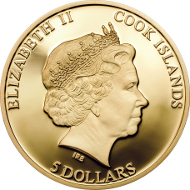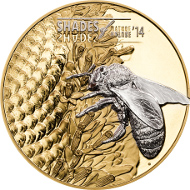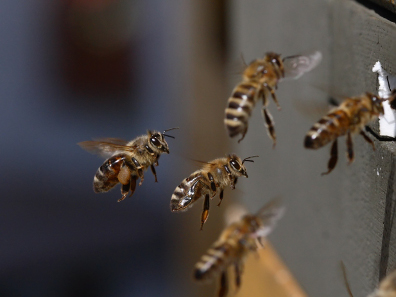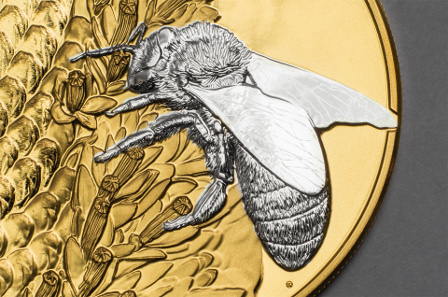May 8, 2014 – Coin Invest Trust issues a new series: Shades of Nature. Thanks to the latest laser technology, the coins reveal nature in all its shades and beauty. The first coin depicts a honeybee in as much detail as if viewed under a microscope.
Cook Islands / 5 Dollars / .925 silver / 25 g / 38.61 mm / Mintage: 2,000.
The coin’s obverse shows a portrait of Elizabeth II, official head of state of the Cook Islands. Engraved along the edges are her name, Elizabeth II, the issuing country, Cook Islands, and the nominal value, 5 Dollars.
The greater part of the coin’s surface on the reverse depicts a close-up view of a flower. In the foreground, a bee sucks out the nectar. The silver bee stands in contrast to the gilded coin. The inscription on the top reads ‘Shades of Nature’ and the year of issue ’14.
What makes this coin special is its minting with the latest laser technology. The technology facilitates the depiction of even the smallest details such as the wing venation or the fringe of hairs on the legs. The tiny symbol engraved below the bee represents the joint product development of CIT and BH Mayer. The coins are minted by B.H. Mayer’s Kunstprägeanstalt GmbH. Collectors can purchase the issue through specialty dealers.
Western honey bee arriving at the hive. Photo: Waugsberg / http://creativecommons.org/licenses/by-sa/3.0/deed.en
‘Sweet as honey’ – the yellow nectar has always been the epitome of sweetness. And the honey-producing bees rightfully deserve the phrase ‘to be busy as a bee’. They go through enormous troubles to produce the delicious food. The tiny animals have to fly out and collect nectar some 100,000 times before one glass of honey ends up on our kitchen table for breakfast!
Since antiquity, bees have been a popular numismatic motif due to their proverbial diligence and the fact that they live in ‘states’ just like humans. Collectors and numismatists will remember the coins of Ephesus or the Prize Medals for Diligence of the 19th century. Though beautiful in their own right, these ancient depictions remain schematic by comparison. Only modern laser technology has achieved a richness of detail which illustrates nature in all its variety and beauty.
Possible thanks to the latest technology: Micro-relief of bee and pollen in minute detail.
Depicted on this coin is a silver bee on a gilded flower. The delicate pistils stretch out to present their stigma to the bee so it can suck out the sweet nectar with its proboscis. The bee stores the nectar in a special organ, the honey sac, and returns to its nest. The nectar will later be transformed into honey.
But the flowers don’t give away their treasure for free. In return for the nectar, the bees help with the plants’ reproduction. Every detail of the body, perfectly designed for its task, is recognisable on the coin: the furry body shines through the paper-thin wings and even the wing venation is visible to the naked eye. You can also clearly make out the tibia, the bigger middle part of the hind legs. The fringe of hairs on it absorbs the pollen like a duster. With the thinner end of the legs, the pollen comb, the bee removes the pollen later on. However, when it lands on the next flower enough pollen will fall off to secure the plants’ pollination and reproduction.
Around 150 different crop plants and 80 per cent of all wild plants in Europe depend on pollination by bees. The animals thus generate an annual ‘revenue’ of 14.2 billion Euros. The tasty honey not yet included!
You can find more information on their products on the Coin Invest Trust website.
In this video you can see a beekeeper catching a bee swarm.
If you are interested in urban beekeeping you may want to read this article written by a beekeeper and his experiences.








